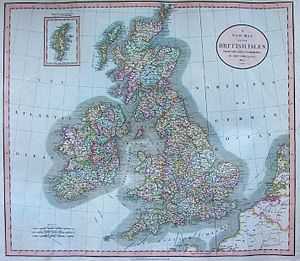John Cary


John Cary (c. 1754 – 1835) was an English cartographer.
Cary served his apprenticeship as an engraver in London, before setting up his own business in the Strand in 1783. He soon gained a reputation for his maps and globes, his atlas, The New and Correct English Atlas published in 1787, becoming a standard reference work in England.
In 1794 Cary was commissioned by the Postmaster General to survey England's roads. This resulted in Cary's New Itinerary (1798), a map of all the major roads in England and Wales. He also produced Ordnance Survey maps prior to 1805.
In his later life he collaborated on geological maps with the geologist William Smith.[1] His business was eventually taken over by G. F. Cruchley (1822–1875).
Cary's major works include:
- Actual Survey of the country fifteen miles around London (1786)
- New and Correct English Atlas (1787)
- Camden's Britannia (1789) - maps for 1789 and 1806 editions
- Cary's Survey of the High Roads from London (1790)
- Cary's Traveller's Companion (1790)
- New Maps of England and Wales with part of Scotland (1794)
- Inland Navigation; or Select Plans of the Several Navigable Canals throughout Britain (1795)
- Cary's New Itinerary (1798)
- A New Map of Scotland (1801)
- New British Atlas (1805), with John Stockdale
- Cary's New Universal Atlas (1808)
- Cary's English Atlas (1809)
- New Elementary Atlas (1813)
- Cary's New Itinerary (1817)
References
- ↑ David Smith, ‘Cary, John (1755–1835)’, rev., Oxford Dictionary of National Biography, Oxford University Press, 2004
- Allen, P. (1992). The Atlas of Atlases. London: Ebury Press.
- Moreland, C. & Bannister, D. (1989) Antique Maps. London: Phaidon Christies
- Tooley, R. V. (1987) Maps and Map-Makers. London: Batsford
External links
| Wikimedia Commons has media related to John Cary. |
|